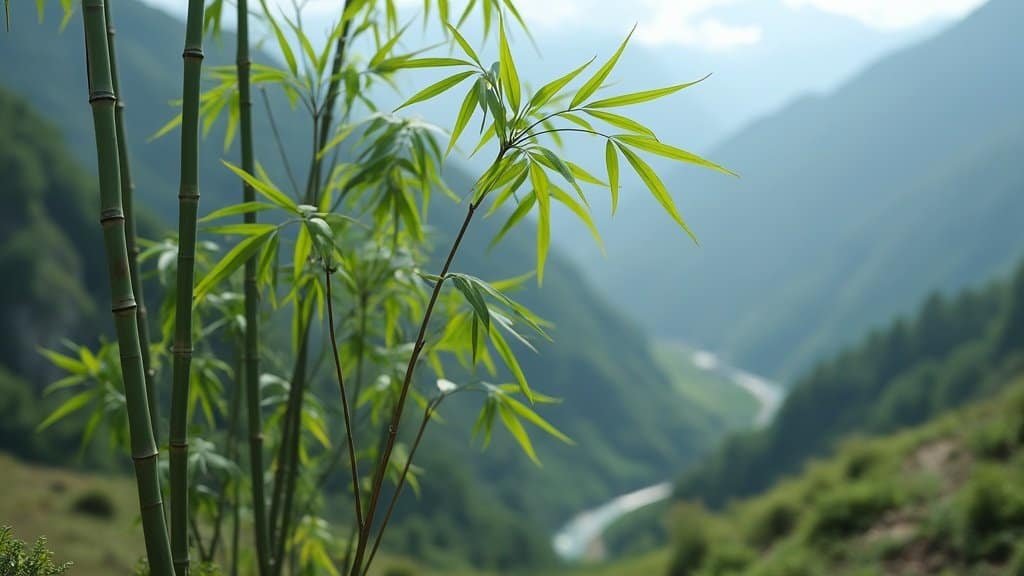Red pandas depend almost entirely on bamboo, but its nutritional quality and availability fluctuate with the seasons. These changes force red pandas to adjust their feeding behavior, metabolism, and food intake throughout the year to survive. In spring and early summer, they consume tender bamboo shoots, which are high in protein and water, allowing them to meet their energy needs efficiently. However, as shoots become scarce in fall, they transition to young leaves, which contain moderate protein but more fiber
Winter presents the greatest challenge, as only mature leaves and stems remain, which are low in protein and difficult to digest. To compensate, red pandas increase their feeding time and lower their metabolic rate, reducing their energy expenditure while surviving on a nutrient-poor diet. Studies show that red pandas may spend up to 13 hours per day foraging in winter, as they must eat larger quantities of bamboo to meet their energy needs
This article explores how seasonal bamboo availability affects red panda feeding habits, the adaptations that help them survive food shortages, and the long-term impact of climate change on their diet
How Bamboo Availability Changes Throughout the Year

Bamboo is the primary food source for red pandas, but its nutritional composition and availability shift with the seasons. These changes directly affect how red pandas select food, how much they eat, and how they regulate their metabolism to survive in different environmental conditions
Growth Cycles and Nutritional Shifts in Bamboo
Bamboo follows distinct seasonal growth cycles, which impact its protein content, moisture levels, and digestibility. In spring and early summer, young bamboo shoots emerge, offering the highest levels of protein (6-8%) and water (75-80%). These shoots are soft, easy to chew, and highly nutritious, making them the preferred food source for red pandas during this period
As summer transitions into fall, bamboo shoots become scarce, and red pandas switch to young leaves, which contain moderate protein levels but more fiber. These leaves are still digestible, but their lower nutrient content forces red pandas to spend more time feeding
By winter, red pandas are left with mature bamboo leaves and stems, which are low in protein (<3%) and high in fiber (35-40%). Because these parts are tougher and harder to break down, digestion requires more energy than it provides, forcing red pandas to increase their feeding time significantly. Research by ScienceDirect (2022) confirms that red pandas consume larger quantities of bamboo in winter to compensate for the decline in nutritional value
Why Red Pandas Prefer Shoots in Spring and Summer
During spring and early summer, red pandas prioritize bamboo shoots due to their high protein and water content. These shoots provide easily digestible energy, allowing red pandas to extract more nutrients with less effort. Since bamboo is naturally low in fat, red pandas must maximize protein intake during this period to build reserves for the colder months
The moisture content of bamboo shoots also plays a role in food selection. Red pandas rely on hydration from food, and spring shoots contain up to 80% water, reducing their need to seek out additional water sources. In contrast, winter bamboo leaves contain significantly less moisture, requiring red pandas to consume more food to stay hydrated (ResearchGate, 2017)
The Challenges of Eating Mature Leaves in Winter
In winter, red pandas face severe dietary challenges, as only mature bamboo leaves and stems remain available. These plant parts are tougher, lower in protein, and high in indigestible fiber, making them nutritionally inferior to spring and summer food sources. Because red pandas have a short digestive tract and limited gut bacteria for fiber breakdown, they struggle to extract energy from mature bamboo
To cope with this nutrient deficiency, red pandas increase their feeding time, often spending up to 13 hours per day eating (Italian Journal of Mammalogy, 2016). Additionally, they lower their metabolic rate, helping them conserve energy while relying on a low-nutrient diet. Despite these adaptations, severe bamboo shortages in winter can lead to malnutrition, reducing red panda survival rates, especially in fragmented habitats
For further details on seasonal bamboo shifts, visit the ResearchGate study on energy utilization in bamboo
How Red Pandas Adapt to Seasonal Bamboo Changes

As bamboo quality and availability fluctuate throughout the year, red pandas must adjust their feeding habits, metabolism, and behavior to survive. These adaptations allow them to cope with nutrient shortages, maximize energy intake, and minimize energy loss during periods of low-quality food availability
Adjustments in Feeding Behavior Based on Bamboo Quality
Red pandas do not consume bamboo indiscriminately; they modify their feeding time and food selection depending on the season and nutrient composition of available bamboo. During spring and early summer, when nutrient-rich shoots are abundant, red pandas consume bamboo more efficiently, requiring less feeding time to meet their energy needs. In contrast, when mature leaves and stems dominate their diet in winter, red pandas spend significantly more time eating to compensate for the lower protein content
Studies from ScienceDirect (2022) confirm that red pandas increase their daily food intake by up to 20% in colder months, ensuring they consume enough low-nutrient bamboo to sustain themselves. This shift in feeding behavior is crucial for survival, as bamboo’s fiber-rich composition requires red pandas to extract as many nutrients as possible from each meal
Metabolic Changes to Survive Low-Nutrient Bamboo Periods
Unlike some animals that store fat reserves for winter survival, red pandas rely on metabolic adjustments to conserve energy. In warmer months, they maintain a normal metabolic rate, as their diet consists of higher-quality bamboo shoots and young leaves. However, in winter, when bamboo is low in protein and difficult to digest, red pandas lower their metabolic rate to reduce energy expenditure
A study by ResearchGate (2017) found that red pandas expend significantly less energy in winter, moving less frequently and resting for longer periods. This adaptation allows them to survive on nutrient-poor food sources without excessive weight loss. Despite this metabolic shift, red pandas must still consume large quantities of bamboo to maintain body weight, as they cannot store enough fat to sustain prolonged periods of food scarcity
The Role of Moisture Content in Red Panda Food Selection
Water availability in bamboo plays a critical role in red panda diet selection. Unlike many mammals that rely on external water sources, red pandas obtain most of their hydration through their food. In spring and summer, bamboo shoots and young leaves contain up to 80% water, helping red pandas stay hydrated with minimal effort. However, in winter, when bamboo moisture levels decline significantly, red pandas must increase their food intake to compensate for reduced hydration levels
When bamboo becomes too dry and fibrous, digestion becomes even more challenging, leading to longer feeding sessions and increased energy expenditure. A study from the Italian Journal of Mammalogy (2016) found that red pandas select bamboo species with higher moisture content whenever possible, demonstrating how hydration plays a role in food selection. This reliance on moisture-rich bamboo highlights the risks of habitat degradation and climate change, as changing rainfall patterns could reduce bamboo hydration levels, making it even harder for red pandas to meet their water needs
For more details on how red pandas adapt to seasonal food changes, visit the ScienceDirect article on bamboo utilization
Challenges Caused by Seasonal Bamboo Scarcity

While red pandas have evolved behavioral and metabolic adaptations to cope with seasonal bamboo changes, they remain highly vulnerable to bamboo shortages. Limited food availability, climate change, habitat loss, and extreme weather patterns can all disrupt their delicate feeding balance, leading to malnutrition and population declines
How Winter Bamboo Shortages Affect Red Panda Survival
Winter is the most challenging season for red pandas, as they must rely on low-protein, high-fiber bamboo leaves and stems. Unlike in spring and summer, when shoots provide easily digestible nutrients, winter bamboo offers less energy, requiring red pandas to increase feeding time to survive. A study from ResearchGate (2017) found that red pandas can spend up to 13 hours a day eating in winter, as they must consume larger quantities of food to compensate for nutrient loss
Despite metabolic adaptations that allow them to reduce energy expenditure, severe bamboo shortages can lead to weight loss, reproductive declines, and increased mortality rates. If food becomes too scarce, red pandas may be forced to expand their foraging range, increasing competition with other animals and exposure to predators. This makes consistent bamboo availability crucial for their survival, especially in fragmented habitats where food sources are limited
Climate Change and Its Impact on Bamboo Availability
Climate change is one of the biggest threats to red panda survival, as rising temperatures and unpredictable weather patterns disrupt bamboo growth cycles. Bamboo forests are highly sensitive to temperature fluctuations and precipitation changes, meaning even slight environmental shifts can impact shoot production and overall food availability
A study from ScienceDirect (2022) highlights that warming climates are delaying bamboo shoot emergence, making it harder for red pandas to access high-protein food sources during critical feeding periods. Additionally, unpredictable rainfall patterns affect bamboo moisture content, leading to drier, less digestible bamboo in winter. These environmental changes increase food scarcity, forcing red pandas to spend more time searching for suitable food, which can further deplete their energy reserves
Alternative Food Sources When Bamboo Is Unavailable
Although red pandas are bamboo specialists, they do consume alternative foods when bamboo becomes scarce. In spring and summer, they may supplement their diet with berries, acorns, flowers, and small invertebrates, providing additional nutrients to sustain them during seasonal transitions. However, these alternative foods are not abundant enough to replace bamboo, making them an insufficient long-term solution for survival
During severe bamboo shortages, red pandas may travel long distances in search of food, leading to increased risks from predators, habitat destruction, and human disturbances. Habitat fragmentation further exacerbates the problem, as it restricts red pandas’ ability to migrate to areas with better food resources. Research from the Italian Journal of Mammalogy (2016) found that red pandas in degraded habitats have higher stress levels and lower body weight, suggesting that habitat loss directly impacts their ability to adapt to seasonal food scarcity
For more details on the long-term effects of seasonal bamboo shortages, visit the ResearchGate study on energy utilization in red pandas













